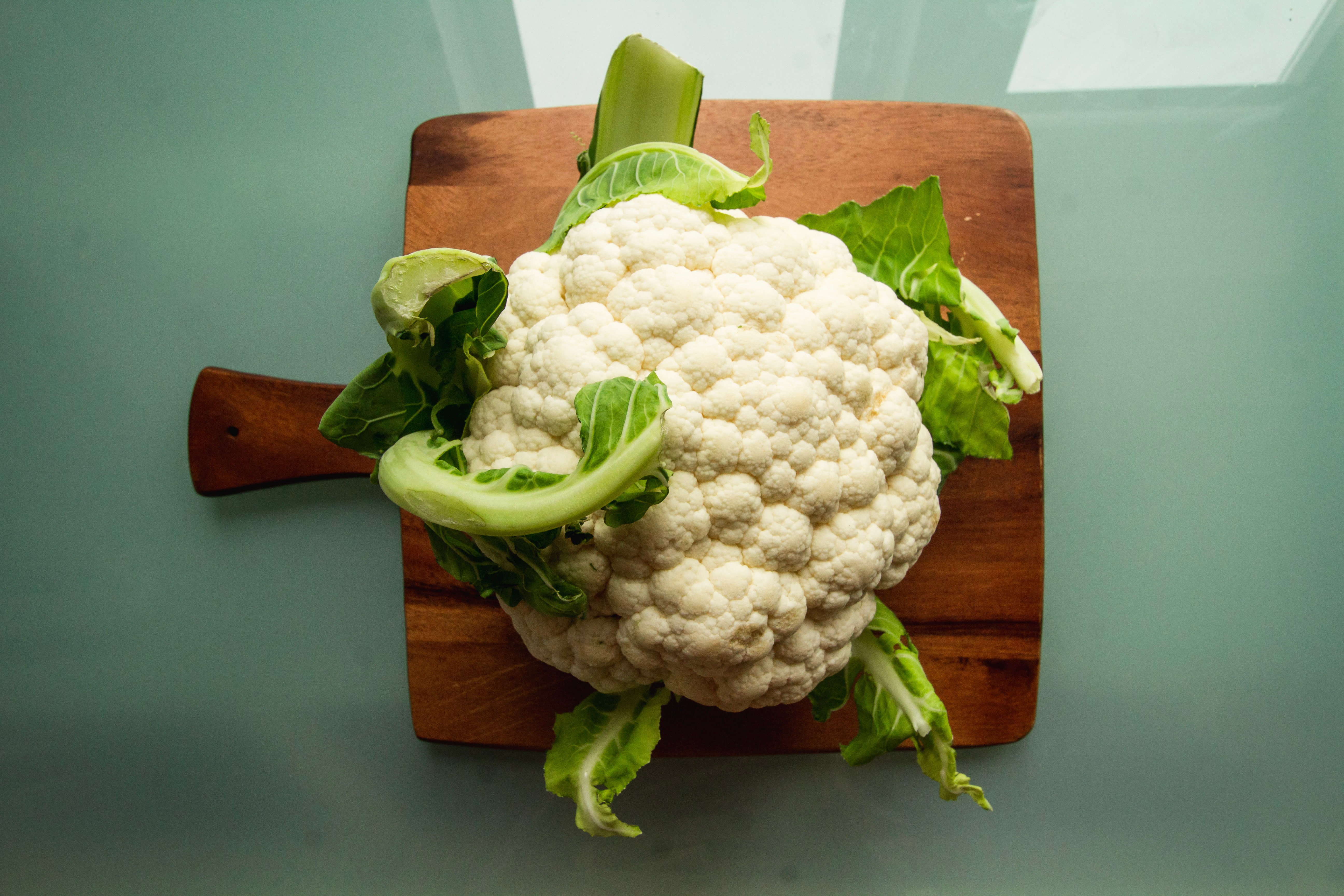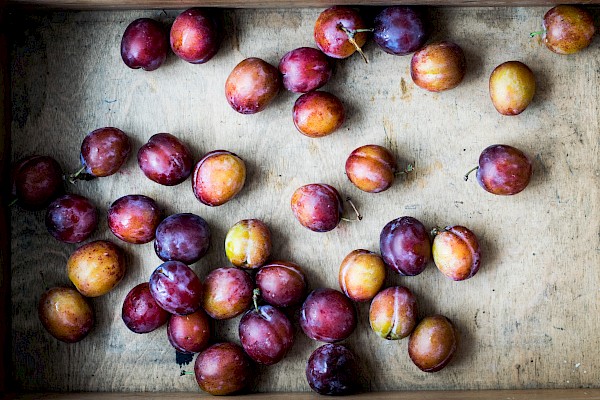Cauliflower
“If cauliflower can be used to make pizza dough, then you can be anything too!”
− Unknown −
Cauliflower in pizza dough? Yes, you read that correctly; it’s a thing. What this is all about and what else you need to know about cauliflower are things you will learn in this article!
Cauliflower’s white, cloud-like appearance has given it a top reputation among the brassicas. Its subtle flavour, so different from the typical taste of cabbage family members, as well as its high nutrient content, have won over many people, including those who are sceptical about its close relatives.
Cauliflower is a member of the brassica family and has a comparably long season, from May to November. Like all brassicas, it originated in the wild, in the Mediterranean region and western Europe. Accordingly it loves a maritime climate and is somewhat demanding to cultivate. White cauliflower has been grown in Switzerland for approximately 500 years. Targeted light deprivation is primarily used to maintain its white colour, as this inhibits the formation of chlorophyll. Cauliflower has been cultivated so that the outer leaves cover the head, protecting it from the sun. Consequently, the cauliflower becomes more strongly coloured the more sunlight it is exposed to. Colourful cauliflower is much more common in countries like France or Italy than they are in Switzerland.
What colour would you like?
When you think of cauliflower, you probably immediately think of the white variety. Yet there really are many different colours of cauliflower, including purple, green and orange. How is that possible? The purple cauliflower contains the anthocyanin pigments also present in red cabbage, which are responsible for the colour. If you’d like even more colour, then you will definitely like the orange or green cauliflowers too. In orange cauliflowers, the beta-carotene content is decisive for the colour, just as it is in carrots. A high chlorophyll content is what makes green cauliflower green.
Nutrients
Cauliflower is popular due to its low calorie-content and it is easy to digest due to its delicate cell structure. Just as kale has recently found a use in smoothies or as crisps, cauliflower too has been “rediscovered”. Recently people have started to use it in pizza dough, and that’s not all. As cauliflower contains fewer calories than, for example, rice, it is also used as a rice substitute, or to replace potato in croquettes, or as a general alternative to flour. Cauliflower’s healthy components don’t stop with its low carb content – it is also rich in vitamin C, folic acid and potassium, making it a real health food. Just one 200 g portion will supply our daily vitamin C requirement. And when it comes to vital substances, the colourful cauli varieties have the upper hand: they contain considerably more vitamins, minerals and protein. This puts cauliflower a step ahead of its brassica relatives.
Preparation and storage
Although cauliflower has a relatively long season and is therefore available fresh for most of the year, it goes bad really quite quickly compared to other brassicas. That’s why we advise you to make sure that the cauliflower head is firm and the surrounding leaves look fresh when you’re shopping. Small black spots or patches on the head indicate that the cauliflower is not as fresh as it could be.
If you don’t eat your cauliflower immediately, but want to keep it for a few days, it’s best to put it into the fridge, but remove the outer leaves first. This way it will definitely stay fresh for four to five days. If you would like to store it for longer, the best method is to blanch it first, then freeze it.
Recipe ideas
Cauliflower’s mild flavour makes it is highly versatile, meaning it is ideal for many different recipes. You can boil it, steam, it, deep-fry it and bake it – anything is possible (yes, even a pizza base!). We have found two recipes for you:
Cauliflower popcorn
For 300 g, you need:
- 600 g cauliflower, cut into small florets
- 3 tablespoons grated Parmesan
- 2 tablespoons olive oil
- 1 tablespoon cornflour
- ½ teaspoon garlic powder
- ¼ teaspoon salt
And here’s how: Mix the cauliflower with the cheese, oil and cornflour, then season. Spread the mixture over a baking sheet lined with baking parchment. Bake in an oven preheated to 200 °C for approximately 25 minutes.
(Cauliflower popcorn – recipes | fooby.ch)
Cauliflower pizza
For 3 portions, you need:
- A round baking tray, 26cm in diameter
- 500 g cauliflower, grated or chopped finely
- 100 g grated Gruyère AOP
- 1 egg
- 1 clove garlic, crushed
- 1 teaspoon salt and pepper
- 1 handful cherry tomatoes, halved
- 1 handful mushrooms, halved or quartered
- 5-10 slices of salami (or other ingredients of your choice)
- 150 g mozzarella
- A few basil leaves and balsamic glaze to garnish
And here’s how: Preheat the oven to 240 °C / 220 °C fan.
Pizza base: knead the cauliflower with the cheese, egg, garlic, salt and pepper in a bowl with your hands. Line the baking sheet with baking parchment, put the cauliflower dough onto it and press it flat. Bake for approximately 10 minutes on the lowest shelf of the preheated oven. Then take the cauliflower base out of the oven and cover with the cherry tomatoes, mushrooms and salami. Finally tear the mozzarella into shreds and place on top. Now bake the cauliflower pizza for approximately 20 minutes on the bottom shelf. Garnish with basil leaves and balsamic glaze.
(Low carb cauliflower pizza – recipe | Swissmilk)
References
5 am Tag. (2022). Blumenkohl. Bundesamt für Lebensmittelsicherheit und Veterinärwesen BLV. Accessible on: https://www.5amtag.ch/wissen/gemuese/blumenkohl/
Chefs Culinar (no date). Blumenkohl. Accessible on: https://www.chefsculinar.de/blumenkohl-1135.htm
Fooby – Foodlexikon. Blumenkohl: Blumenkohl ist der Kabis für alle – sogar für Kabisskeptiker. Accessible on: https://fooby.ch/de/kochschule/foodlexikon/blumenkohl.html?gclsrc=aw.ds&gclid=EAIaIQobChMIhd-qr93C_wIV-4RoCR378QZuEAMYASAAEgIW5fD_BwE&startAuto1=4
Verband Schweizer Gemüseproduzenten (no date). Blumenkohl. Accessible on: Blumenkohl | Schweizer Gemüse (gemuese.ch)
 subscribe to newsletter
subscribe to newsletter


